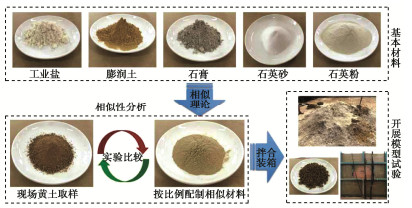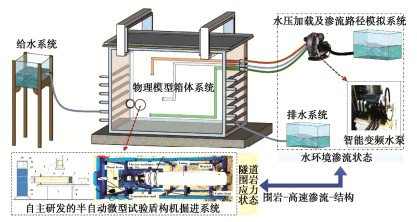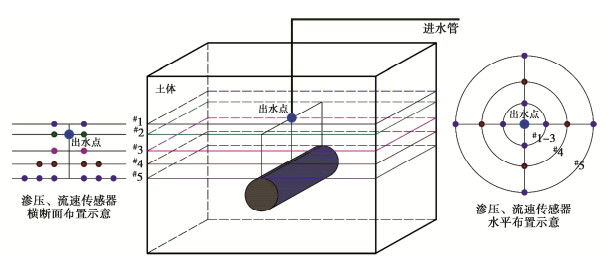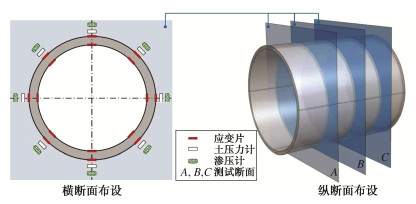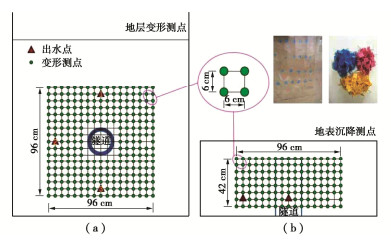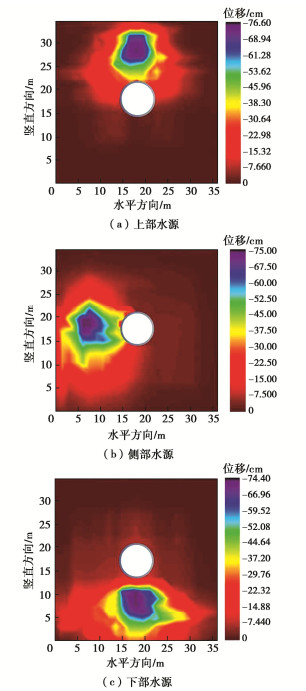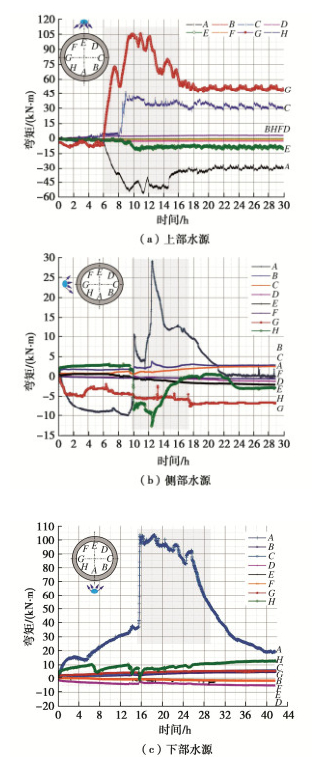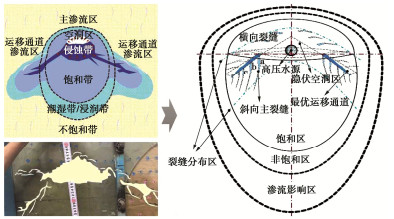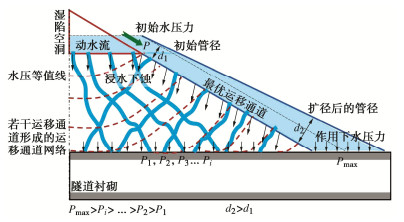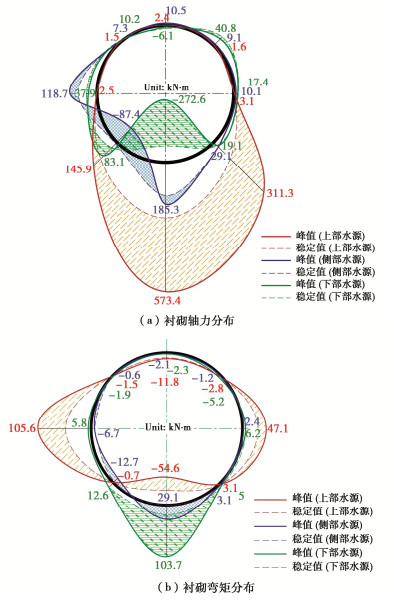Step effects of hydraulic pressure of metro tunnels in loess under sudden high-pressure seepage
-
摘要: 高压水源外泄具有突发性、快速性和释能效应,诱发的黄土围岩灾变性态及隧道结构劣化影响要比静力入渗作用更严重。为揭示高压渗流作用下黄土围岩水压阶跃效应的传递特征、诱因及其对隧道结构受力的影响规律,通过开展相似模型试验,对黄土围岩渗流性态的时空演化及隧道力学响应进行研究。研究表明:突发高压渗流过程依次经历了黄土局部湿陷侵蚀→产生隐伏空腔→形成优势通道→围岩水压及结构内力阶跃波动→渗流趋于稳定;局部湿陷势释放和优势运移通道的孕育发展是围岩水压及结构受力阶跃波动的主要原因;在不同水源位置下,起拱线以下衬砌内力变化均显著大于上部结构,且拱底位置受力影响最大,其中在上部水源时轴力的最大阶跃增幅为324 kN,在下部水源时弯矩的最大阶跃增幅为84 kN·m;优势运移通道下侧围岩区域所受影响最大,在不同水源位置下衬砌内力影响程度表现为上部水源>下部水源>侧部水源。Abstract: The leakage of a high-pressure water source has sudden, rapid and energy-release effects. Its destructive behavior of surrounding rock of loess and deterioration of tunnel structures is more severe than static infiltration. To reveal the transmission characteristics and inducement of the step effects of surrounding rock of loess under high-pressure seepage as well as the influences on the tunnel structures, the temporal and spatial evolution of seepage behavior of surrounding rock of loess and the mechanical response of tunnels are studied through the similar model tests. The research shows that the seepage process has successively experienced local collapsible erosion of loess → generation of the hidden cavity → formation of the preferential channels → step fluctuation of water pressure of surrounding rock, and structural internal force→seepage stability. The release of the local collapsible potential and the development of the preferential seepage channels are the main reasons for the step fluctuation of the water pressure of surrounding rock and structural stress. Under different water source locations, the changes of internal force of linings below the arch springing line are significantly greater than those of the upper structures, and the arch bottom location is most affected by the force. The maximum step increase of its axial force is 324 kN under the upper water source, and that of its bending moment is 84 kN·m under the lower water source. The surrounding rock area at the lower side of the dominant preferential channel is most affected. The influence degree of the internal force of linings under different water source positions is shown as upper water source > lower water source > side water source.
-
Keywords:
- metro tunnel /
- loess stratum /
- high-pressure seepage /
- step effect /
- mechanical response
-
0. 引言
中国中西部地区黄土分布广泛[1-3],当黄土受水浸湿后结构性易丧失,关于黄土地铁在建设和运营过程中水灾害的报导也屡见不鲜[4],尤其当隧道周边高压水源(满流输水管线、暴雨灾害、城市人工河道、黄河水系等)突发外泄时,此时高水力梯度会造成围岩内部产生非稳态高压渗流现象[5-6]。高水压驱动下产生的惯性力沿渗流路径不断积累,引发围岩侵蚀与隐伏空洞,诱发新裂隙的萌生、扩展并跟踪传递,在临近既有地铁隧道间形成水流运移通道[7-10],致使地层及隧道结构失稳破坏而形成地面塌陷。通过对中国城市隧道地面塌陷事故案例进行统计分析[11-12],由地下管线渗漏或破坏诱发的地面塌陷及周边工程事故占比38%,其次,城市人工河道及河流水系诱发涌水也是造成工程事故的重要诱因。以西安市为例,大部分隧址区土层为新黄土,西安地裂缝活动[13]及雨季影响每年会造成近20处供/排水管道破裂漏水[14-15]。
目前,对富水地层地铁隧道结构安全问题研究已取得了丰硕成果,但多以静力入渗作为试验和分析的主要条件。王念秦等[16]对原状非饱和黄土试样进行了不同压力水头条件下的向上渗流试验,发现浸水锋面推进的位移和时间近似呈抛物线关系,渗流过程按照渗透速率的快慢可分为快速入渗阶段、缓慢入渗阶段和趋稳入渗阶段;基于西安地铁4号线隧道工程,邵生俊等[17-18]对湿陷性黄土隧道开展了静力浸水试验,发现由于水荷载作用,土颗粒产生流失运移,当水体运移通道形成后,水压力作用在隧道结构上,致使结构破坏;考虑黄土地层局部不均匀浸水和全幅均匀静力浸水条件,翁效林等[19]、张玉伟等[20]通过模型试验研究了隧道结构受力、土压力及隧道位移变化规律,发现地表全幅静力浸水对隧道结构受力影响最明显,但隧道位移相对较小,基底均匀静力浸水对隧道结构受力影响较小,但隧道位移相对较大。
鉴于高压水源外泄具有突发性、快速性和释能效应,高压渗流作用诱发的围岩灾变性态及隧道结构劣化影响要比静力入渗作用更为严重,尤其在黄土围岩局部湿陷势释放与突发高水压的双重影响下表现出的水压阶跃效应,即围岩水压从一种水力状态快速阶跃至另一种水力状态,并伴随波动和能量释放转化过程[21-22]。目前对高压渗流作用下黄土地铁隧道灾变模式的研究,主要集中于灾变后期结构的表征分析和灾害处治,而对前期的诱灾和传递规律却鲜有研究。基于此,以西安地铁某区间隧道管线漏水事故为背景,通过开展模型试验,对突发高压渗流作用下黄土地铁隧道围岩的灾变演化规律进行研究,直观定量揭示高水压驱动下围岩水压阶跃效应的传递特征、诱因及其对隧道结构受力的影响规律,以期完善复杂水环境赋存条件下黄土地铁隧道安全评价体系,提升中国黄土地铁隧道容灾能力及抗灾韧性。
1. 模型试验
1.1 模型相似性
采用量纲分析法,根据试验条件,确定模型与原型相似比n=25。在本模型试验中,将几何尺寸(l)、渗透系数(k)和重度(γ)作为基本物理量,几何相似比Cl=25,重度相似比Cγ=1,渗透系数相似比Ck=1,计算得出各物理量参数相似比(表 1)。
表 1 物理参数相似比Table 1. Similarity ratios of physical parameters物理量 量纲 相似关系 相似比 长度l L Cl=25 25 重度γ M T-2L-2 Cγ=1 1 渗透系数k T-1L Ck=1 1 应力σ MT-2L-1 Cσ=ClCγ 25 弹性模量E MT-2L-1 CE=Cσ 25 时间t T Ct=Cl/Ck 25 渗流量Q T-1L3 CQ=CkCl2 625 渗流速度V T-1L Cv=Ck 1 水压力u MT-2L-1 Cu=Cσ 25 泊松比ν L Cν=1 1 1.2 模型材料及试验装置
(1)相似材料配比设计
基于现场黄土取样分析,选取石膏、膨润土、工业盐、石英粉、砂等基本材料,配制能反映黄土湿陷性和结构性的试验相似材料(图 1)。以重度和湿陷系数作为主要控制指标,设置4种不同湿陷性配比方案(表 2)。配制黄土试样的干密度取值1.27~1.30 g/cm3与隧址区黄土的干密度取值1.10~1.68 g/cm3相符,土粒相对质量密度取值为2.63~2.66,与天然黄土土粒相对质量密度相符。
表 2 湿陷性黄土配比方案设计Table 2. Design of proportioning scheme for collapsible loess tests试样 石英粉/% 石英砂/% 膨润土/% 石膏/% 工业盐/% 干密度/(g·cm-3) Gs 孔隙比 1 35 30 20 10 5 1.28 2.63 1.06 2 40 25 20 10 5 1.27 2.63 1.07 3 35 30 25 5 5 1.30 2.65 1.04 4 30 30 30 5 5 1.30 2.66 1.04 湿陷性黄土试样的黏聚力c取值范围确定为42.67~64.24 kPa,平均值为51.10 kPa,利用反三角函数原理计算得出4种相似材料内摩擦角处于23.51°~28.15°,平均值为25.31°。由配制土样的e-p曲线可得,配制的黄土压缩系数a1-2取值为0.37~0.44 MPa-1,平均值为0.41 MPa-1。根据室内试验和现场勘察资料可知,现场取样黄土黏聚力为22~48 kPa,平均值为32 kPa,内摩擦角处于20°~35°,平均值为24°。现场黄土试样的压缩系数a1-2为0.28~0.62 MPa-1,平均值为0.45 MPa-1。试验制备土样的物理力学参数与现场土样基本相符,且湿陷程度明显(湿陷系数δs为0.04~0.08),湿陷系数随压力的增加而变大,前期变化快,后期变化幅度降低,整体符合天然黄土的湿陷变形规律。综上分析,试验制备土样与天然黄土满足相似条件,可用于模型试验。对比现场土样的物理力学性质,最终确定模型试验中围岩材料配合比为∶石英粉∶石英砂∶膨润土∶石膏∶工业盐∶水=35∶30∶20∶10∶5∶8。
将水、石膏和硅藻土按照比例拌和,通过预制模具加工成试样,模拟管片衬砌(图 2)。经过不同配比材料试验,试件的特征曲线可拟合成斜率K=0.0338的直线形式,考虑到原型管片衬砌混凝土的强度等级为C50,管片衬砌相似材料采用配合比为水∶石膏∶硅藻土=1∶1.35∶0.1。
(2)试验装置
模型试验系统主要由物理模型箱系统、水压加载及渗流路径模拟系统和传感及采集系统组成(图 3)。模型箱尺寸为1.5 m(长)×0.6 m(宽)×1.5 m(高),模型箱采用透明钢化玻璃,以便实时观测模型箱内部情况。通过采用变频水泵及电动控制阀来有效模拟具有特定初始水压力的局部动水源,实现精确模拟高压渗流环境下的土层渗透性态。据中国城市给排水管道相关规定,城市管道水压一般为0.25 MPa,本试验设置变频水泵水压为10 kPa。为控制试验变量因素,保证每组水量相同。根据地铁隧道中实际管片结构,本试验管片衬砌的设计参数见表 3所示。试验所测得的数据,均已根据相似理论换算成原型。
表 3 模型支护结构厚度设计Table 3. Parameters of tunnel model结构型式 弹性模量/GPa 泊松比 厚度/m 直径/m 类型 型号 原型 模型 原型 模型 原型 模型 原型 模型 管片衬砌 C50 34.5 1.46 0.2 0.2 0.3 0.0118 6 0.25 1.3 测试方案设计
(1)围岩渗压测试
结合实际管线布设情况,试验中分别在隧道上部、侧部和下部设置高压水源。如图 4所示,围绕出水点布设多个测试层,每个测试层布置相应的多个测点(SY-1、SY-2、SY-3、SY-4、SY-5、SY-6等)。
(2)隧道结构测试
为分析突发高压渗流作用下隧道压力水头及结构内力的影响规律,选择3个测试断面(断面A,B,C),水源位于断面A,3个断面等间距布设(10 cm)。传感器布设主要包括隧道周边水压力测试和隧道结构应变测试(图 5),获得结构应力及衬砌内力。
(3)围岩变形测试
为分析试验过程中围岩及地表的变形规律,在模型箱正面及侧面按每格6 cm×6 cm规格绘制监测网格,并在每个网格角点处插入特制大头针作为测点。地层变形测点布置共17(列)×17(行),如图 6(a)所示;地表变形测点布置共17(列)×8(行),如图 6(b)所示。
2. 突发高压渗流下围岩性态时空演化
2.1 围岩浸润性态
以隧道上部突发高压入渗为例,对黄土围岩进行切片处理(图 7),直观定量分析浸水锋面的浸润时空规律。水源附近具有较高含水量,存在应力集中,为土体塑性变形(湿陷势)创造了有利条件。局部高压渗流过程中,浸润范围绕水源沿不同方向呈不同分布特征,随着水量持续增加,湿陷锋面按含水量的分布向四周推进,逐渐逼向最终边界,围岩局部湿陷稳定时间对应于湿陷区的某一稳定下限。
对于产生的隐伏空腔,其顶部在水源上方约0.5 m,其底部在水源下方约3 m,在剖面上近似呈三角形,上部窄,下部宽,平面最大跨度为2.5 m,位于水源下方1.5~2.5 m。对于浸水锋面,在水源上方和下方同一深度处的推进范围明显不同,水源上方的浸水锋面范围明显小于下方。浸润范围在水平面上近似呈圆形分布:水源上方1.5 m,浸润半径约2.75 m;水源上方0.5 m,浸润半径约5.05 m;水源处,浸润半径约5.1 m;水源下方0.5 m,浸润半径约5.1 m;水源下方1.5 m,浸润半径约5.0 m;水源下方2.5 m,浸润半径约5.85 m。高压渗流作用下,浸润发展主要发生在水源下方,浸润向上发展速率远小于向下发展,最大浸润范围位于水源下方2.5 m,说明水源所在平面并非渗流最快区域,隐伏空腔最大跨度所在平面的浸润影响范围最大,而且由于运移通道发展导致浸润范围圆心与水源位置不重合。在水源下方约2.5 m出现优势水流运移通道,增大了浸水空间,改变了浸水锋面的推进方向和范围,此时下层浸水锋面围绕水源和运移通道共同推进。
2.2 围岩位移变化规律
(1)隧道上部突发高压入渗
上部高压水源时,由图 8(a)可知,围岩隐伏空腔最大位移76 cm,水平约25 m,竖向影响范围约17.5 m。位移分布以洞轴为中心近似呈椭圆形对称分布。沉降集中分布在隧道上部,且越靠近隧道,位移越小,隧道周围的沉降范围为7~15 cm。同时,水源位于隧道上部时,地表沉降量较大,达5~7 cm。
(2)隧道侧部突发高压入渗
侧部高压水源时,由图 8(b)可知,围岩隐伏空腔最大位移达75 cm。围岩变形对隧道左侧影响较大,隧道拱脚处围岩位移变化较显著,约30~40 cm。湿陷范围水平分布较小而竖向分布较大,近似呈竖立椭圆形。水源上方地表沉降最大约为5 cm。
(3)隧道下部突发高压入渗
下部高压水源时,由图 8(c)可知,围岩隐伏空腔最大位移74 cm,产生的水平影响范围约27 m,竖向约12.5 m。湿陷区域以洞轴为中心呈扁平状对称分布。与前两种工况相比,靠近隧道一侧的围岩位移相对较小,且变化梯度更大,隧道周边位移为10 cm左右,位移减少幅度约45%。同时,水源位于隧道下部时,地表沉降较小,约2 cm。
2.3 围岩水压力变化规律
(1)隧道上部突发高压入渗
突发高压渗流前期,先后经历了急剧波动阶段(0~9 h)、基本稳定阶段(9~18 h)、快速增长阶段(18~22 h)和缓慢增长阶段(≥22 h)(图 9(a))。测点水压力变化先后顺序为:1→2→3→4→5→6,即靠近水源位置的测点(测点1和2)水压力最先变化,靠近隧道位置的测点随后也发生变化。测点3,4,5和6位于同一平面,由于测点3位于水源正下方,水压力相对较大。沿铅直方向,测点1和2的水压力变化规律基本相似,渗流前期,水压力出现多次波动,随后稳定增长,18 h左右隧道出现渗水迹象,此时水压力快速增长,整个过程测点1和2水压力相差约20 kPa,22 h左右水压力缓慢增长,测点1和2的水压力最终达到210,190 kPa。测点3的水压力变化也呈现一定波动性,水压力最终达到148 kPa。其余测点(4,5和6)水压力变化规律基本相似,水压力均表现为逐渐增大,最终分别达到73,63,57 kPa。
(2)隧道侧部突发高压入渗
由图 9(b)所示的渗压时程曲线可知,0~14 h为急剧波动阶段,大于14 h后分别呈现快速增长阶段、快速降低阶段或缓慢增长阶段。测点水压力变化先后顺序为:2→1→4→6→5→3。靠近水源位置的测点1,2的水压力波动较大,最大水压力分别为100,90 kPa,经历较大波动后,进入快速变化阶段。尽管测点1,2与水源的水平距离相同,但水压变化规律却有所差别,测点1,2的水压力在渗流前4 h内发生急剧变化,体现了渗流的突发性;随后测点2水压力急剧降低,进入连续波动阶段,保持在23 kPa左右,而测点1的水压力降低幅度较小,连续波动阶段保持在85 kPa左右;最后测点1的水压力进入快速下降阶段,降低到32 kPa,而测点2的水压力进入快速上升阶段,上升到54 kPa。靠近隧道一侧(测点3,4,5,6)的水压力变化规律基本相似,测点水压力缓慢增大,并后期保持稳定,水压力分别为3,8,4,4 kPa。
(3)隧道下部突发高压入渗
由图 9(c)所示的渗压时程曲线可知,0~8 h为急剧波动阶段,8~14 h为基本稳定阶段,超过14 h后部分测点进入缓慢增长阶段。测点水压力变化的先后顺序为:1→2→3→6→4→5。沿铅直方向,测点1和2的水压力变化规律基本相似,渗流前期波动剧烈,进入短暂稳定后,缓慢增长,测点1和2的水压力最终稳定在128,122 kPa。测点4水压力由缓慢增长最终达到稳定阶段,稳定水压力为77 kPa。测点3水压力由急剧波动增长进入快速下降阶段,最大水压达82 kPa。运移通道的发展影响围岩水压力的稳定,每次水压力阶跃波动,表明运移通道的发展或新的通道形成。其余测点(5,6)的水压力变化规律基本相似,水压力均先增大后稳定,最终分别稳定于48,21 kPa。
3. 突发高压渗流下隧道力学响应规律
3.1 隧道上部突发高压入渗
水源位于隧道上部时(图 10(a)),隧道上部结构(测点C,D,E,F,G)轴力基本不发生变化,墙脚(测点B,H)轴力先减小,后发生阶跃增幅,最大增幅约+324 kN,随后增幅逐渐降低,稳定在+100 kN;仰拱底部(测点A)轴力变化最大,在渗流中期发生阶跃增幅至+580 kN,后增幅逐渐减小,最终轴力增值稳定在+247.05 kN。对于弯矩变化(图 11(a)),隧道帮部(测点C,G)增幅较大,前期最大约+105 kN·m,后期趋于稳定约+50 kN·m;隧道顶部和底部(测点A,E)弯矩减小,前期降低约-55 kN·m,并在后期趋于稳定约-30 kN·m。
3.2 隧道侧部突发高压入渗
水源位于隧道侧部时(图 10(b)),拱顶、拱肩及右侧边墙(测点E,F,D,B,C)轴力基本不变,左侧边墙及右侧墙脚(测点G,B)轴力逐渐增加,左侧墙脚(测点H)轴力先缓慢增大,后骤降至-89 kN,随后又逐渐增大至先前峰值水平,最终又缓慢降低至零。拱底(测点A)轴力先增大约+187 kN,稳定一段时间后先降低后逐渐增大,随后又出现更强烈的阶跃波动。侧部突发高压入渗时,靠近水源侧的测点A和H变化规律类似,左侧边墙轴力变化相比右侧显著。弯矩变化和轴力类似(图 11(b)),测点A和H波动幅度最大,拱底最大弯矩变化为+29 kN·m,左侧拱脚最大弯矩变化为-13 kN·m。
3.3 隧道下部突发高压入渗
水源位于隧道下部时(图 10(c)),拱顶(测点E)轴力逐渐减小,拱肩、边墙及墙脚(测点H,D,G,B,C,F)轴力缓慢增大,拱底(测点A)轴力先急剧增大+192 kN,后逐渐减小,15 h后急剧减小至-273kN,波动一段时间后缓慢增加,最终轴力为+80 kN。对于弯矩变化(图 11(c)),与轴力变化规律类似,拱底位置的变化幅度及波动程度最大达+104 kN·m,阶跃波动后,降低至+19 kN·m,其余位置弯矩变化幅度相对较小,拱顶、拱肩(测点F,E,D)弯矩减小,边墙、墙脚(测点H,C,G,B)弯矩缓慢增大。
4. 围岩水压阶跃效应影响讨论
4.1 围岩水压阶跃效应传递特征
突发高压渗流下,围岩水压经历了多次阶跃波动,均表现为靠近水源位置的测点水压力先发生急剧波动,随后部分靠近隧道结构位置的测点也相应发生波动,最后趋于稳定。根据试验结果,将黄土围岩渗流演化归纳为3个阶段:①局部湿崩阶段:渗流开始,高压水流直接作用于附近黄土,随着内圈黄土接近饱和,其入渗能力大幅降低,围岩局部湿陷势释放,形成以水源为中心的隐伏空腔,腔周伴随多组分散的水平裂缝和向下倾斜裂缝。此阶段,水源附近的黄土在高压水侵蚀下逐渐分解,并随水流运移最终滞留于空腔中,通过周围裂缝向外部土壤不断渗流,此时渗流速率减缓。②运移通道发展阶段:随着空腔充填水量增多,堆积物逐渐被悬浮,弱化渗流封堵作用。水压持续作用下,向下的裂缝数量增加,并逐渐相互联通,沿空腔两腰形成了集中的优势运移通道。通道的形成为后续的渗流提供了“捷径”,在高水压力驱动下运移通道水体紊动性不断加剧,此时运移通道发展过程中不稳定水流运动导致了渗流及结构响应的阶跃效应,既围岩水压和隧道结构受力出现明显的波动。③稳定渗透阶段:随水流动力势能释放,运移通道发展逐渐停止,被水流裹挟的土体最终聚集在通道底部,阻碍通道进一步发展。最后,将黄土地层渗流影响区沿铅锤方向划分为3个区域:隐伏空腔区、饱和渗流区和非饱和渗流区(图 12)。在优势运移通道上方,湿陷裂缝呈水平或者弧形开展,并沿着优势通道和空洞区平行走向;而在优势运移通道下方,湿陷裂缝呈倾向开展。优势通道下方,饱和浸水区和非饱和区分布于空洞区下方的虚线(湿陷锋面)范围内。
4.2 围岩水压阶跃效应产生诱因
突发高压渗流下的阶跃效应是一种“必然式”的链生转化,即局部突发高压渗流→黄土局部湿陷侵蚀→隐伏空腔→优势通道→围岩水压及结构受力阶跃波动。综合来看,阶跃效应的产生是黄土围岩的局部湿陷势释放(内在诱因)和优势运移通道的孕育发展(关键诱因)共同导致。其中黄土围岩的局部湿陷势释放使得围绕水源位置形成了隐伏空腔以及围绕周围丰富的横向、斜向裂缝,综合考虑黄土地层不同方向的渗流差异,并结合试验现象中空腔形状呈现上窄下宽的空间分布形式,推演隐伏空腔在剖面上呈不规则三角形。隐伏空腔的出现一方面在未产生优势通道前成为了渗流过程中短暂的积水平台,聚积了大量水流动力势能;另一方面也为后续的渗流路径累积以及优势通道发展提供了条件和方向。由试验结果可知,运移通道发展阶段对应围岩水压及结构受力阶跃波动阶段。在优势运移通道发展过程,通道中紊流产生的旋涡运动及对土颗粒的推移作用,不断将土体颗粒分散和游离成泥沙,其中沿纵向的旋涡运动一般产生通道下蚀现象,而沿横向的旋涡运动则通常产生侧蚀现象并伴随通道的不断扩大。在围岩既有裂缝的导通与浸水下蚀的双重影响下,以分布在空洞两腰的优势运移通道为边界,在水源与隧道间的围岩最终形成了一个错综复杂的潜在运移通道网络(图 13)。在通道影响下,不同渗流路径下的非稳态入渗改变了围岩水力分布状态,在运移通道发展过程中,围岩水压出现间断性的波动增长,作用到衬砌上使得部分结构内力出现明显的阶跃增幅,其中以沿着优势运移通道快速下渗的水流对隧道结构的影响最为突出。随着渗水范围的逐渐扩散,水流动力势能不断释放,通道发展逐渐停止,水压力逐渐减小,衬砌内力变化趋于稳定。
4.3 围岩水压阶跃效应对隧道结构的影响特征
图 14揭示了不同水源位置衬砌内力峰值和最终稳定值的分布对比,图中阴影区域代表了阶跃增幅。通过对比发现,相较于渗流后期的稳定值,衬砌部分位置的内力在渗流过程中出现了明显的阶跃波动。上部水源时,衬砌下部(拱底、右墙脚和左边墙)轴力出现明显阶跃增幅(324,208,47 kN),整体呈“梨”形分布;隧道拱底和左边墙弯矩的阶跃增幅较大(57,23 kN·m),整体呈“横8”形分布。侧部水源时,临近侧衬砌下部(拱底、左墙脚和左边墙)轴力出现明显阶跃增幅(122,96,29 kN),整体呈“下凸”形分布;隧道拱底和左墙脚弯矩的阶跃增幅较大(29,9 kN·m),整体呈“下凸”形分布。下部水源时,衬砌下部(拱底和左墙脚)轴力出现明显阶跃增幅(200,127 kN),整体呈“下凹”形分布;隧道拱底和左墙脚弯矩的阶跃增幅较大(84,14 kN·m),整体呈“下凸”形分布。
在不同水源位置下,起拱线以下衬砌内力变化均显著大于上部结构,且拱底位置受力影响最大。结合围岩水压阶跃效应的传递特征,优势运移通道下侧围岩区域所受影响最大。当水源位于隧道上部时,衬砌下部位于优势运移通道的直接作用区域,此时衬砌内力波动最剧烈,且阶跃增幅最大;当水源位于隧道下部时,隧道距离运移通道较远,因此衬砌变化波动远小于上部水源,但是由于下部隐伏空腔的影响,在渗流阶段产生了脱空效应,拱底的轴力与弯矩仍表现出较大增幅;当水源位于隧道侧部时,临近侧衬砌位于优势运移通道的上部,因此该部位衬砌内力阶跃增幅相对较大,但是由于土体渗流差异的影响,衬砌内力的阶跃增幅小于上部水源。总的来说,在不同水源位置下衬砌内力受力程度表现为上部水源>下部水源>侧部水源。
5. 结论
(1)突发高压渗流下,围岩水压出现了多次阶跃波动,黄土围岩渗流演化归纳为局部湿崩阶段、运移通道发展阶段和稳定渗透阶段。局部湿崩阶段内水源附近黄土在水体侵蚀下逐渐崩解,形成了以水源为中心的圆锥状隐伏空腔;运移通道发展阶段内随着高压水沿渗流路径不断累积和裂缝扩展,沿空腔两腰形成了集中的优势运移通道,造成围岩水压波动并伴随激增;随着水流动力势能释放,通道发展逐渐停止,围岩水压逐渐趋于稳定。
(2)突发高压渗流过程中衬砌内力出现了不同程度的阶跃波动。不同水源位置下,衬砌起拱线以下内力变化均显著大于上部结构,且拱底位置受力影响最大。上部水源时,衬砌轴力和弯矩峰值分别呈“梨”形和“横8”形,拱底轴力和弯矩的阶跃增幅分别为324 kN,57 kN·m;侧部水源时,衬砌轴力和弯矩峰值均呈“下凸”形分布,拱底轴力和弯矩的阶跃增幅分别为122 kN,29 kN·m;下部水源时,衬砌轴力和弯矩峰值分别呈“下凹”形和“下凸”形分布,拱底轴力和弯矩的阶跃增幅分别为200 kN,84 kN·m。
(3)突发高压渗流下的阶跃效应是一种“必然式”的链生转化,即局部突发高压渗流→黄土局部湿陷侵蚀→隐伏空腔→优势通道→围岩水压及结构受力阶跃波动。其中黄土围岩的局部湿陷势释放使得围绕水源位置形成了隐伏空腔以及腔周丰富的横、斜向裂缝,为后续的渗流路径累积及优势通道发展提供了条件和方向。而运移通道的形成为后续的水流运动提供了捷径,在通道影响下,不同渗流路径下的非稳态入渗改变了围岩水力分布状态,使得围岩水压出现间断性的波动增长,作用到衬砌上使得部分结构内力出现明显的阶跃增幅。
(4)优势运移通道下侧围岩区域所受影响最大,在不同水源位置下衬砌内力受力程度表现为上部水源>下部水源>侧部水源。水源位于隧道上部时,隧道下部位于优势运移通道的直接作用区域,此时衬砌内力波动最剧烈且阶跃增幅最大;水源位于隧道下部或者侧部时,隧道距离运移通道较远,内力变化波动远小于上部水源。而水源位于隧道下部时,由于下部隐伏空腔的影响,在渗流阶段产生了脱空效应,拱底的轴力与弯矩增幅要略大于侧部水源。
目前,针对黄土地铁隧道高压渗流作用下的灾变演化机制研究仍需不断完善,而非稳态渗流下围岩产生的水压阶跃效应影响即为诱灾、致灾的关键。后续将开展更丰富的多因素试验,并探究能有效模拟突发高压渗流过程的数值模拟方法,以期对本文研究结果进行补充和完善。
-
表 1 物理参数相似比
Table 1 Similarity ratios of physical parameters
物理量 量纲 相似关系 相似比 长度l L Cl=25 25 重度γ M T-2L-2 Cγ=1 1 渗透系数k T-1L Ck=1 1 应力σ MT-2L-1 Cσ=ClCγ 25 弹性模量E MT-2L-1 CE=Cσ 25 时间t T Ct=Cl/Ck 25 渗流量Q T-1L3 CQ=CkCl2 625 渗流速度V T-1L Cv=Ck 1 水压力u MT-2L-1 Cu=Cσ 25 泊松比ν L Cν=1 1 表 2 湿陷性黄土配比方案设计
Table 2 Design of proportioning scheme for collapsible loess tests
试样 石英粉/% 石英砂/% 膨润土/% 石膏/% 工业盐/% 干密度/(g·cm-3) Gs 孔隙比 1 35 30 20 10 5 1.28 2.63 1.06 2 40 25 20 10 5 1.27 2.63 1.07 3 35 30 25 5 5 1.30 2.65 1.04 4 30 30 30 5 5 1.30 2.66 1.04 表 3 模型支护结构厚度设计
Table 3 Parameters of tunnel model
结构型式 弹性模量/GPa 泊松比 厚度/m 直径/m 类型 型号 原型 模型 原型 模型 原型 模型 原型 模型 管片衬砌 C50 34.5 1.46 0.2 0.2 0.3 0.0118 6 0.25 -
[1] 钱鸿缙, 王继唐, 罗宇生, 等. 湿陷性黄土地基[M]. 北京: 中国建筑工业出版社, 1985. QIAN Hongjin, WANG Jitang, LUO Yusheng, et al. Collapsible Loess Foundation[M]. Beijing: China Architecture & Building Press, 1985. (in Chinese)
[2] 王树明, 梁庆国, 王二磊. 黄土地区地铁隧道不同湿陷变形方式模型试验系统的研制及应用研究[J]. 现代隧道技术, 2020, 57(2): 157-162. https://www.cnki.com.cn/Article/CJFDTOTAL-XDSD202002023.htm WANG Shuming, LIANG Qingguo, WANG Erlei. Development and application research of a model test of different collapsible deformation modes of a metro tunnel in the loess area[J]. Modern Tunnelling Technology, 2020, 57(2): 157-162. (in Chinese) https://www.cnki.com.cn/Article/CJFDTOTAL-XDSD202002023.htm
[3] LIU Z, LIU F Y, MA F L, et al. Collapsibility, composition, and microstructure of loess in China[J]. Canadian Geotechnical Journal, 2016, 53(4): 673-686. doi: 10.1139/cgj-2015-0285
[4] PENG J B, FAN Z J, WU D, et al. Heavy rainfall triggered loess-mudstone landslide and subsequent debris flow in Tianshui, China[J]. Engineering Geology, 2015, 186: 79-90. doi: 10.1016/j.enggeo.2014.08.015
[5] 和晓楠, 周晓敏, 郭小红, 等. 深埋隧道注浆加固围岩非达西渗流场及应力场解析[J]. 中国公路学报, 2020, 33(12): 200-211. doi: 10.3969/j.issn.1001-7372.2020.12.016 HE Xiaonan, ZHOU Xiaomin, GUO Xiaohong, et al. Analysis of non-Darcy seepage field and stress field of surrounding rock strengthened by grouting in deep buried tunnel[J]. China Journal of Highway and Transport, 2020, 33(12): 200-211. (in Chinese) doi: 10.3969/j.issn.1001-7372.2020.12.016
[6] 张治国, 汪嘉程, 赵其华, 等. 富水山岭地区邻近补水断层隧道结构上的水头分布解析求解[J]. 岩石力学与工程学报, 2020, 39(S2): 3378-3394. doi: 10.13722/j.cnki.jrme.2019.0920 ZHANG Zhiguo, WANG Jiacheng, ZHAO Qihua, et al. Analytical solution of head distribution on tunnel structure adjacent water-filled fault in water-enriched mountain region[J]. Chinese Journal of Rock Mechanics and Engineering, 2020, 39(S2): 3378-3394. (in Chinese) doi: 10.13722/j.cnki.jrme.2019.0920
[7] 张成平, 张顶立, 王梦恕, 等. 城市隧道施工诱发的地面塌陷灾变机制及其控制[J]. 岩土力学, 2010, 31(增刊1): 303-309. doi: 10.16285/j.rsm.2010.s1.041 ZHANG Chengping, ZHANG Dingli, WANG Mengshu, et al. Catastrophe mechanism and control technology of ground collapse induced by urban tunneling[J]. Rock and Soil Mechanics, 2010, 31(S1): 303-309. (in Chinese) doi: 10.16285/j.rsm.2010.s1.041
[8] QIU J L, WANG X L, LAI J X, et al. Response characteristics and preventions for seismic subsidence of loess in Northwest China[J]. Natural Hazards, 2018, 92(3): 1909-1935. doi: 10.1007/s11069-018-3272-5
[9] 刘成禹, 陈博文, 罗洪林, 等. 满流条件下管道破损诱发渗流侵蚀的试验研究[J]. 岩土力学, 2020, 41(1): 1-10. https://www.cnki.com.cn/Article/CJFDTOTAL-YTLX202001002.htm LIU Chengyu, CHEN Bowen, LUO Honglin, et al. Experimental study of seepage erosion induced by pipeline damage under full pipe flow condition[J]. Rock and Soil Mechanics, 2020, 41(1): 1-10. (in Chinese) https://www.cnki.com.cn/Article/CJFDTOTAL-YTLX202001002.htm
[10] 王明年, 董宇苍, 于丽. 基于双线性强度准则的黄土隧道围岩弹塑性解析解[J]. 中国铁道科学, 2019, 40(6): 68-77. https://www.cnki.com.cn/Article/CJFDTOTAL-ZGTK201906010.htm WANG Mingnian, DONG Yucang, YU Li. Elastoplastic analytical solution to surrounding rock of loess tunnel based on bilinear strength criterion[J]. China Railway Science, 2019, 40(6): 68-77. (in Chinese) https://www.cnki.com.cn/Article/CJFDTOTAL-ZGTK201906010.htm
[11] 李兴高, 王霆. 刚性管线纵向应变计算及安全评价[J]. 岩土力学, 2008, 29(12): 3299-3302, 3306. doi: 10.3969/j.issn.1000-7598.2008.12.022 LI Xinggao, WANG Ting. Longitudinal strain calculation and safety evaluation of rigid pipelines[J]. Rock and Soil Mechanics, 2008, 29(12): 3299-3302, 3306. (in Chinese) doi: 10.3969/j.issn.1000-7598.2008.12.022
[12] 侯艳娟, 张顶立, 李鹏飞. 北京地铁施工安全事故分析及防治对策[J]. 北京交通大学学报, 2009, 33(3): 52-59. https://www.cnki.com.cn/Article/CJFDTOTAL-BFJT200903010.htm HOU Yanjuan, ZHANG Dingli, LI Pengfei. Analysis and control measures of safety accidents in Beijing subway construction[J]. Journal of Beijing Jiaotong University, 2009, 33(3): 52-59. (in Chinese) https://www.cnki.com.cn/Article/CJFDTOTAL-BFJT200903010.htm
[13] 党发宁, 高闯洲, 党维维, 等. 西安f7地裂缝发展变化的预测研究[J]. 自然灾害学报, 2012, 21(3): 170-176. https://www.cnki.com.cn/Article/CJFDTOTAL-ZRZH201203025.htm DANG Faning, GAO Chuangzhou, DANG Weiwei, et al. Predictive research on development and change of ground fissures f7 in Xi'an[J]. Journal of Natural Disasters, 2012, 21(3): 170-176. (in Chinese) https://www.cnki.com.cn/Article/CJFDTOTAL-ZRZH201203025.htm
[14] 高虎艳, 黄强兵, 王德志, 等. 西安地铁三号线隧道斜交穿越地裂缝带的设防参数研究[J]. 现代隧道技术, 2012, 49(6): 128-132, 146. https://www.cnki.com.cn/Article/CJFDTOTAL-XDSD201206022.htm GAO Huyan, HUANG Qiangbing, WANG Dezhi, et al. A study of design parameters for the tunnels of the Xi'an metro line 3 passing obliquely through active ground fissure zones[J]. Modern Tunnelling Technology, 2012, 49(6): 128-132, 146. (in Chinese) https://www.cnki.com.cn/Article/CJFDTOTAL-XDSD201206022.htm
[15] 任建喜, 张杨洋. 斜穿地裂缝黄土地铁隧道施工诱发的地表沉降及隧道变形规律研究[J]. 铁道标准设计, 2015, 59(9): 112-117. https://www.cnki.com.cn/Article/CJFDTOTAL-TDBS201509026.htm REN Jianxi, ZHANG Yangyang. Study on settlement laws of ground surface and tunnel deformation induced by construction of loess metro runnel crossing ground fissure[J]. Railway Standard Design, 2015, 59(9): 112-117. (in Chinese) https://www.cnki.com.cn/Article/CJFDTOTAL-TDBS201509026.htm
[16] 王念秦, 庞琦, 韩波, 等. 原状非饱和离石黄土向上渗流规律试验研究[J]. 水文地质工程地质, 2015, 42(1): 112-117. https://www.cnki.com.cn/Article/CJFDTOTAL-SWDG201501020.htm WANG Nianqin, PANG Qi, HAN Bo, et al. Experimental study of the upward seepage law of the intact unsaturated Lishi loess[J]. Hydrogeology & Engineering Geology, 2015, 42(1): 112-117. (in Chinese) https://www.cnki.com.cn/Article/CJFDTOTAL-SWDG201501020.htm
[17] 邵生俊, 李骏, 李国良, 等. 大厚度湿陷性黄土隧道现场浸水试验研究[J]. 岩土工程学报, 2018, 40(8): 1395-1404. doi: 10.11779/CJGE201808004 SHAO Shengjun, LI Jun, LI Guoliang, et al. Field immersion tests on tunnel in large-thickness collapsible loess[J]. Chinese Journal of Geotechnical Engineering, 2018, 40(8): 1395-1404. (in Chinese) doi: 10.11779/CJGE201808004
[18] 邵生俊, 陈菲, 邵帅. 黄土隧道地基湿陷变形评价方法探讨[J]. 岩石力学与工程学报, 2017, 36(5): 1289-1300. https://www.cnki.com.cn/Article/CJFDTOTAL-YSLX201705024.htm SHAO Shengjun, CHEN Fei, SHAO Shuai. Collapse deformation evaluation method of loess tunnel foundation[J]. Chinese Journal of Rock Mechanics and Engineering, 2017, 36(5): 1289-1300. (in Chinese) https://www.cnki.com.cn/Article/CJFDTOTAL-YSLX201705024.htm
[19] 翁效林, 王俊, 王立新, 等. 黄土地层浸水湿陷对地铁隧道影响试验研究[J]. 岩土工程学报, 2016, 38(8): 1374-1380. doi: 10.11779/CJGE201608003 WENG Xiaolin, WANG Jun, WANG Lixin, et al. Experimental research on influence of loess collapsibility on subway tunnels[J]. Chinese Journal of Geotechnical Engineering, 2016, 38(8): 1374-1380. (in Chinese) doi: 10.11779/CJGE201608003
[20] 张玉伟, 宋战平, 翁效林, 等. 大厚度黄土地层浸水湿陷对地铁隧道影响的模型试验研究[J]. 岩石力学与工程学报, 2019, 38(5): 1030-1040. https://www.cnki.com.cn/Article/CJFDTOTAL-YSLX201905017.htm ZHANG Yuwei, SONG Zhanping, WENG Xiaolin, et al. Model test study on influence of the collapsibility of large thickness loess stratum on subway tunnels[J]. Chinese Journal of Rock Mechanics and Engineering, 2019, 38(5): 1030-1040. (in Chinese) https://www.cnki.com.cn/Article/CJFDTOTAL-YSLX201905017.htm
[21] QIU J L, LU Y Q, LAI J X, et al. Failure behavior investigation of loess metro tunnel under local-high-pressure water environment[J]. Engineering Failure Analysis, 2020, 115: 104631.
[22] QIU J L, LU Y Q, LAI J X, et al. Experimental study on the effect of water gushing on loess metro tunnel[J]. Environmental Earth Sciences, 2020, 79(11): 1-19.
-
期刊类型引用(5)
1. 费国标,汪文清,黄娴. 高压水压工作站设计. 工程机械. 2025(01): 37-41+8 .  百度学术
百度学术
2. 邱军领,贾玎,赖金星,唐琨杰,强磊. 含裂隙土质隧道降雨入渗双通道渗流模型. 岩土工程学报. 2025(03): 548-558 .  本站查看
本站查看
3. 荣巍,苏旭林,赵楚军,黄小通. 穿越不良地质带隧道结构响应规律模型实验平台设计. 实验技术与管理. 2024(07): 119-127 .  百度学术
百度学术
4. 王恩波,昝文博,张喆,王强. 基坑开挖对下卧地铁隧道结构的扰动效应分析. 甘肃科学学报. 2024(05): 16-23 .  百度学术
百度学术
5. 黎秋锋. 海底隧道混凝土抗氯离子渗透性能研究. 水利技术监督. 2024(11): 173-175 .  百度学术
百度学术
其他类型引用(1)
-
其他相关附件



 下载:
下载:
